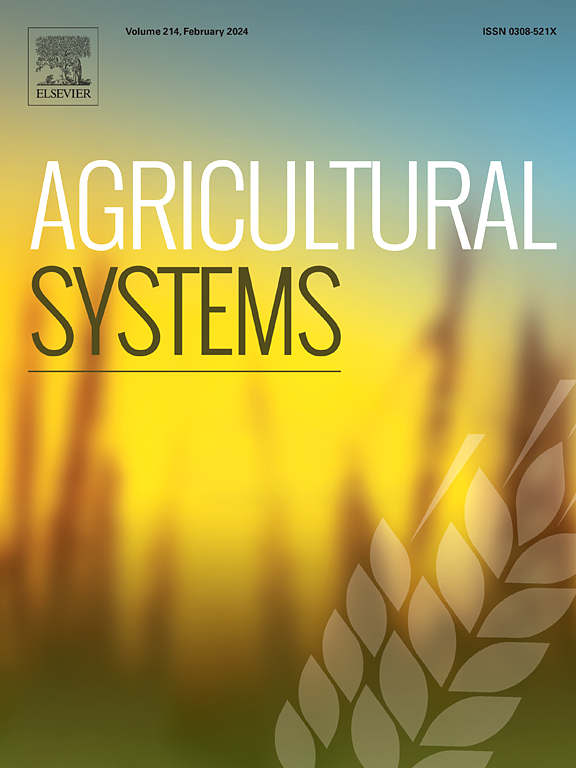改良的区域氮循环在作物-牲畜系统中的环境影响-一种通用的建模方法
IF 6.1
1区 农林科学
Q1 AGRICULTURE, MULTIDISCIPLINARY
引用次数: 0
摘要
减少外部投入(饲料、肥料)可实现更多的养分循环,并减少环境损失,尤其是在集约化耕作系统中。然而,由于潜在的利弊权衡,农场管理的变化可能会在更高的总规模上产生意想不到的后果。本文章由计算机程序翻译,如有差异,请以英文原文为准。

Environmental effects of improved regional nitrogen cycling in crop-livestock systems – A generic modelling approach
CONTEXT
More nutrient cycling may be achieved by using less external inputs (feed, fertilisers) and reduce losses to the environment, especially in intensive farming systems. Yet, changes in on-farm management may have unintended consequences at higher aggregation scales due to potential trade-offs.
OBJECTIVE
The objective of this study was to develop a multi-indicator and multi-level model which operates at farm and regional level to evaluate scenarios for improved nitrogen cycling.
METHODS
A new model, based on nitrogen flow analysis, was used to compare five scenarios with the current situation as reference. The model was applied to a case study region, the Dutch province Drenthe including typical arable, pig, poultry, and dairy farms. In the scenarios, the proportion of manure digested for biogas production, and imported amounts of synthetic fertiliser and feed into the region were varied, as single measures or in combination.
RESULTS AND CONCLUSIONS
Modelling results showed that digestion of manure for biogas production reduced total regional nitrogen losses and produced renewable energy. A 20 % decrease in synthetic nitrogen fertiliser application reduced crop yields only slightly and improved the regional nitrogen use efficiency and nitrogen cycling, as manure availability in Drenthe was sufficient to meet a large proportion of the total crop nutrient requirements. Combining multiple measures was most effective in increasing nitrogen cycling (+65 %), leading to reduced greenhouse gas emissions (−49 %) and an improved net energy balance (+84 %) from agriculture in Drenthe, with the largest contribution coming from restricting feed import (resulting in a reduction of the total livestock herd in the region). However, when livestock was reduced, more synthetic nitrogen fertiliser was needed to maintain crop yields.
Our study also highlighted trade-offs: positive effects on nitrogen cycling, greenhouse gas emissions and nitrogen losses coincided with reduced food production and organic matter inputs to soils, with consequences for carbon stocks. Furthermore, results for the whole region were not always representative for each farm type.
SIGNIFICANCE
The results demonstrate that our systems approach, quantifying multiple indicators simultaneously at farm and region level, can provide a better understanding of benefits and trade-offs when aiming for an agricultural system which is productive, but with reduced emissions to the environment. The developed model is generic and can be applied to evaluate alternative nitrogen cycling scenarios in other European regions with only little parameterisation needed from publicly available data.
求助全文
通过发布文献求助,成功后即可免费获取论文全文。
去求助
来源期刊

Agricultural Systems
农林科学-农业综合
CiteScore
13.30
自引率
7.60%
发文量
174
审稿时长
30 days
期刊介绍:
Agricultural Systems is an international journal that deals with interactions - among the components of agricultural systems, among hierarchical levels of agricultural systems, between agricultural and other land use systems, and between agricultural systems and their natural, social and economic environments.
The scope includes the development and application of systems analysis methodologies in the following areas:
Systems approaches in the sustainable intensification of agriculture; pathways for sustainable intensification; crop-livestock integration; farm-level resource allocation; quantification of benefits and trade-offs at farm to landscape levels; integrative, participatory and dynamic modelling approaches for qualitative and quantitative assessments of agricultural systems and decision making;
The interactions between agricultural and non-agricultural landscapes; the multiple services of agricultural systems; food security and the environment;
Global change and adaptation science; transformational adaptations as driven by changes in climate, policy, values and attitudes influencing the design of farming systems;
Development and application of farming systems design tools and methods for impact, scenario and case study analysis; managing the complexities of dynamic agricultural systems; innovation systems and multi stakeholder arrangements that support or promote change and (or) inform policy decisions.
 求助内容:
求助内容: 应助结果提醒方式:
应助结果提醒方式:


